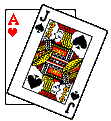



| "If you're gonna play the game, boy, ya gotta learn to play it right." |
|
- Kenny Rogers |
Follow
Basic Strategy
|
Just what is Basic Strategy? Simply put, Basic Strategy is the optimum way for a player to play his hands, if he's not counting cards, given a prescribed set of house rules. Given any blackjack scenario, there is only one correct play. No guesswork should ever be involved. Basic Strategy, which has been derived by several blackjack experts through detailed computer analysis, is an exact a science as mathematics. While playing blackjack, would you ever double with 10, 10 vs. a dealer's upcard of a 10? The answer should be no, of course not. But why not? The dealer might have a 10 in the hole, in which case you would tie, and yet if you took a hit, you might catch an Ace and beat him! But of course with this example the answer is clear... most of the time you won't catch that Ace and you'll simply go over 21 and bust. If you were to play over that above scenario a million times, you would indeed catch that Ace occasionally. But overall it would be a very, very bad move. Well, this same logic applies to all scenarios!!!! That's what Basic Strategy is...it's the optimum way one should play each and every hand! Sometimes the correct play however may "seem" wrong! For example, it is indeed correct to hit a 10, 5 or a 10, 6 against a 10. Yet, I see many players who don't do this because they are "afraid" of busting. But it has been proven, over millions of hands, you will lose less by hitting!! Granted, 15 and 16 against a 10 are bad hands. Whether you hit or stand, in the long run you are going to lose. But at least make the play that loses less!! This chart I put together shows the correct way to play every possible hand in a single deck blackjack game, where doubling after splitting is allowed. This chart should be memorized and followed religiously!! It's not hard to do. And if you don't memorize it, at least while playing at Yahoo!, have it on your screen off to the side so you can consult it when you need to! |
|
|
The numbers at the top of the columns represent the dealer's upcard. The rows represent the hand you have. The corresponding box represents the play you should make. For example, if you were dealt two 6's, you would split when the dealer was showing a 2, 3, 4, 5, 6, or 7 and hit when the dealer had an 8, 9, 10, or Ace. |
| It is imperative you follow this chart! At times it may be
hard, I agree! And many times you are going to follow it and lose! Yes,
that happens! But you have to make the play that will be the best for
you in the long run!
When I follow it, it is very hard to ever get upset when the dealer, for example, miraculously beats my 20 with his 21... because I know I made the right play! For the moment I have this chart (well, actually a similar one that is a little larger) as my Windows wallpaper! Because of this I've been forced to look at it regularIy and I do believe I finally have the dang thing memorized again! (15 years ago I had it memorized, when I was regularly playing in casinos.) Note: Depending on what source you read, you may find a couple of minor differences with this chart and the one you may come across. For example, I have one book which says a player should stand with total of 12 against a dealer's upcard of a 3. However, I have more sources which indicate a hit is in order and therefore that's the way I have chosen to play. Also note that standing with 7-7 against a ten with a single deck is an advanced play. (Other references indicate a hit here.) Because of the flaw I found here at a Yahoo!, where the dealer hits on hard 17s when they include an Ace, even this chart might not be 100% correct. If I get ambitious enough, I may write a blackjack simulation program (as a computer programmer this is easily within my capabilities) which will produce a chart for such playing conditions. Until then though, this will have to suffice. |